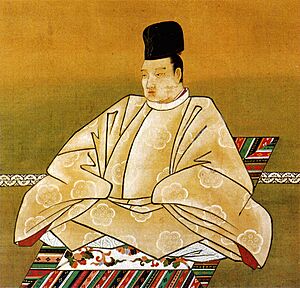Emperor Go-Sai facts for kids
Quick facts for kids Emperor Go-Sai後西天皇 |
|||||
|---|---|---|---|---|---|

Go-Sai by Prince Kōben
|
|||||
| Emperor of Japan | |||||
| Reign | January 5, 1655 – March 5, 1663 | ||||
| Coronation | February 17, 1656 | ||||
| Predecessor | Go-Kōmyō | ||||
| Successor | Reigen | ||||
| Shōguns | Tokugawa Ietsuna | ||||
| Born | Nagahito (良仁) January 1, 1638 Kyoto, Kyoto Prefecture, Tokugawa shogunate |
||||
| Died | March 26, 1685 (aged 47) Tokugawa shogunate (Japan) |
||||
| Burial | Tsuki no wa no misasagi, Kyoto | ||||
| Spouse | Akiko | ||||
| Issue | See below | ||||
|
|||||
| House | Yamato | ||||
| Father | Emperor Go-Mizunoo | ||||
| Mother | Kushige (Fujiwara) Takako | ||||
Nagahito (Japanese: 良仁), later known as Emperor Go-Sai (後西天皇, Go-Sai-tennō, January 1, 1638 – March 22, 1685), was the 111th emperor of Japan. He ruled from 1655 to 1663.
His name, Go-Sai, means "Later Emperor Junna." This was because he faced similar challenges as the earlier Emperor Junna. Go-Sai could not pass the throne to his own children. He was also sometimes called "Emperor of the Western Palace."
Contents
Go-Sai's Family
Before he became emperor, his personal name was Nagahito or Yoshihito. He was also known as Hide-no-miya.
Emperor Go-Sai was the eighth son of Emperor Go-Mizunoo. He was raised by Tōfuku-mon'in. His older half-siblings included former Empress Meishō and former Emperor Go-Kōmyō.
Emperor Go-Sai lived in the Dairi (Inner Palace) with his family. He had many children, including at least 16 sons and 17 daughters. None of his children became emperor.
His main wife was Princess Akiko. Some of his notable children included:
- Imperial Princess Tomoko (his first daughter)
- Imperial Prince Hachijō-no-miya Osahito (his first son)
- Imperial Prince Arisugawa-no-miya Yukihito (his second son)
- Imperial Prince Priest Kōben (his sixth son)
- Imperial Prince Satohito (his sixteenth son), who later became Emperor Reigen.
Important Events During Go-Sai's Reign
Nagahito became emperor after his older brother, Emperor Go-Kōmyō, died. This meant the throne was empty, and Nagahito took over. His time as emperor happened when Tokugawa Ietsuna was the powerful leader of the Tokugawa shogunate.
Go-Sai married Princess Akiko, the daughter of Prince Takamatsu-no-miya Yoshihito. Go-Sai became emperor for a short time until his younger brother, Imperial Prince Satohito, was old enough to rule.
Here are some key events from his life and reign:
- January 1, 1638: Nagahito, who would become Emperor Go-Sai, was born.
- January 5, 1655: Emperor Go-Kōmyō died. Nagahito became the new emperor.
- 1655: A new ambassador from Korea arrived in Japan.
- March 2–3, 1657: The Great Fire of Meireki happened. This huge fire destroyed much of the city of Edo (modern-day Tokyo).
- 1659: Construction started on the Ryōgoku Bridge in Edo.
- 1661: The Imperial Palace in Kyoto burned down. The Gekū (a very important shrine) was also badly damaged by fire.
- March 20, 1662: A strong earthquake hit Kyoto. It destroyed the tomb of Toyotomi Hideyoshi, a famous historical leader.
- 1662: Emperor Go-Sai asked a painter named Tosa Hiromichi to take the name Sumiyoshi. This painter then became the official artist for the Sumiyoshi Taisha shrine.
- March 5, 1663: Emperor Go-Sai stepped down from the throne. His younger brother, Prince Satohito, became the new emperor, known as Emperor Reigen.
After he stopped being emperor, Go-Sai focused on learning and writing. He wrote many books, including the "Water and Sun Collection." He was also very good at waka (a type of Japanese poetry) and knew a lot about classic literature.
During his reign, there were many disasters. These included big fires at the Ise Shrine, Osaka Castle, and the Imperial Palace. There were also earthquakes and floods. Because of these events, some people thought the emperor was unlucky.
- March 26, 1685: Former Emperor Go-Sai died. Around this time, a large comet was seen in the night sky.
Emperor Go-Sai is buried in the imperial tomb called Tsuki no wa no misasagi at Sennyū-ji temple in Kyoto. Many other emperors and empresses are also buried there, including his father, Emperor Go-Mizunoo, and his successors like Emperor Reigen.
At the Kitano Shrine, there is a tablet above the main gate with the word tenmangu written in Emperor Go-Sai's own handwriting.
Court Officials (Kugyō)
The Kugyō were a small group of very powerful men who worked for the Emperor of Japan before the modern Meiji era. Even when the emperor's power was limited, these officials held important positions.
This group usually had only three or four men at a time. They were born into noble families and had a lot of experience. During Emperor Go-Sai's reign, the top officials included:
- Kampaku, Nijō Mitsuhira (a chief advisor)
- Sadaijin (Minister of the Left)
- Udaijin (Minister of the Right)
- Naidaijin (Minister of the Center)
- Dainagon (Chief Counselor)
Eras of Go-Sai's Reign
The years of Emperor Go-Sai's rule are known by different era names or nengō:
See also
 In Spanish: Go-Sai Tennō para niños
In Spanish: Go-Sai Tennō para niños
- Emperor of Japan
- List of Emperors of Japan
- Imperial cult

